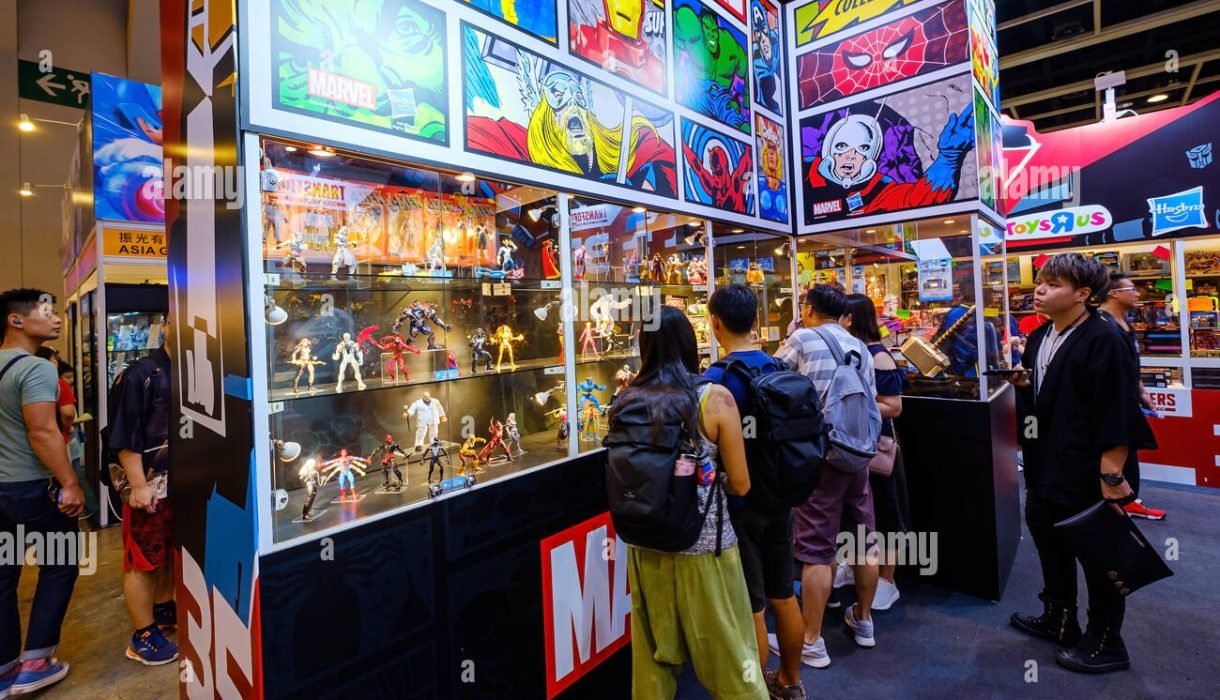
China’s Toy Empire Turns Its Back on America as Tariffs Bite Deep.
Posted in :
With U.S. tariffs on Chinese toys reaching up to 245%, Yiwu sellers are abandoning American buyers and turning to emerging markets, while U.S. retailers face empty shelves, price hikes, and a potential collapse of the toy industry.
Impact of U.S. tariffs on Chinese toy exports, examining how the Yiwu market adapts to shifting demand amidst global changes.
Imagine walking through the vibrant streets of Yiwu, China, where the air buzzes with chatter about toy deals—sounds lively, right? But behind this bustle is a striking shift in the toy market as American tariffs reshape the landscape dramatically.
The Impact of Tariffs on the Toy Industry
Understanding Tariffs
Tariffs are essentially taxes imposed on imported goods. They are designed to make foreign products more expensive, encouraging consumers to buy domestic items instead. In the case of the toy industry, these tariffs can reach staggering rates—up to 245%. This means that a toy that once cost $10 could now cost over $34. Such increases can significantly alter purchasing decisions.
Statistics on U.S. Toy Imports
The toy market is a massive industry. In 2022, China exported approximately $34 billion worth of toys globally. Out of this, around $10 billion was sold to the United States. This figure highlights the importance of the U.S. market for Chinese toy manufacturers. However, with the rise of tariffs, many sellers are reconsidering their reliance on American buyers.
Changing Dynamics in Yiwu
In Yiwu, a bustling city known for its toy market, the atmosphere is shifting. Sellers who once focused primarily on American customers are now exploring new markets. One seller candidly stated,
“We don’t need America,”
emphasizing their newfound focus on regions like South America and the Middle East. This change reflects a broader trend among Chinese exporters who are adapting to the pressures of U.S. tariffs.
Personal Anecdotes from Yiwu Sellers
Many sellers in Yiwu have shared their experiences regarding the changing sales dynamics. They describe a vibrant marketplace filled with colorful toys, where the buzz of business is palpable. Yet, the sentiment has shifted. Sellers are now decorating their shops with signs in Spanish and Arabic, signaling their intent to attract buyers from other countries.
- One seller noted that they are now receiving regular visits from buyers in Dubai, Colombia, and Nigeria.
- Another mentioned that Christmas decorations, which typically dominated sales to the U.S., are now being packed for South American homes.
This adaptability showcases the resilience of the Yiwu market. While the U.S. market may be shrinking due to tariffs, sellers are finding opportunities elsewhere. They are not just waiting for the storm to pass; they are actively seeking new customers.
The Broader Impact on the Toy Industry
The implications of these tariffs extend beyond just the sellers in Yiwu. In the United States, many small toy companies are feeling the pinch. Some shop owners have expressed concerns that the entire toy industry could collapse if these tariffs remain in place. The reality is stark: most toys in American stores are still manufactured in China. Finding alternative suppliers is not an easy task.
Many U.S. toy shops have already canceled orders worth hundreds of thousands of dollars. Others are left with stock they cannot sell at higher prices. This situation could lead to emptier shelves, especially during peak shopping seasons like the holidays. Major retailers like Walmart and Target have also warned that prices will rise and products may run out. They have communicated to the U.S. government that supply issues could persist well into the holiday season.
Challenges for Chinese Exporters
Chinese exporters are not immune to the effects of these tariffs. Factories in cities like Guangzhou are experiencing a slowdown in shipments to the U.S. Some have goods piling up, waiting for buyers who are now hesitant. The timing is particularly challenging, as China’s economy is already grappling with weak consumer spending and a housing crisis. Tariffs add another layer of difficulty to an already strained economic landscape.
As the trade war between China and the U.S. continues, the toy industry is undergoing significant changes. Sellers in Yiwu are adapting by seeking new markets and diversifying their customer base. While the challenges are real, the resilience and adaptability of these sellers demonstrate a willingness to move forward, regardless of the pressures from tariffs.
Diversifying Customer Base: Adapting Strategies
In recent months, sellers have been forced to rethink their customer profiles. As demand shifts from the U.S. to other markets, particularly in South America and the Middle East, businesses are adapting their strategies. This change is not just about finding new buyers; it’s about understanding different cultures and purchasing behaviors.
New Buyers in South America and the Middle East
Many sellers are now actively seeking customers in regions that were previously overlooked. South America and the Middle East are emerging as key markets. Why? The answer lies in the changing dynamics of international trade. With tariffs making it more expensive to sell to the U.S., sellers are looking for alternatives.
- In South America, buyers are eager for products that were once primarily shipped to the U.S.
- The Middle East presents a growing market with increasing purchasing power.
As one South American buyer stated,
“This trade war opens doors for us to collaborate with China more than before.”
This sentiment reflects a broader trend where sellers are no longer reliant on American consumers.
Changes in Marketing Strategies
With new markets come new challenges. Sellers are adapting their marketing strategies to cater to diverse audiences. This includes:
- New language signs: Shops are now displaying greetings in Spanish and Arabic to attract local buyers.
- Cultural adaptations: Understanding local customs and preferences is crucial for successful outreach.
These changes are not just superficial. They represent a deeper understanding of the markets being explored. Sellers are learning that effective communication is key to building relationships with new customers.
Anecdotes About New Customers
As sellers engage with new buyers, they are discovering unique purchasing behaviors. For instance, customers from South America often prefer bulk purchases, which can lead to significant sales increases. In contrast, buyers from the Middle East may focus on luxury items, reflecting their market’s preferences.
One seller shared an experience of a buyer from Colombia who was thrilled to find high-quality toys at competitive prices. This buyer expressed excitement about the potential for future orders, highlighting the importance of building trust and rapport.
Such anecdotes illustrate the evolving landscape of international trade. Sellers are not just shipping products; they are forging connections that can lead to long-term partnerships.
Strategic Changes in Customer Outreach
To effectively reach these new markets, sellers are implementing strategic changes in their outreach efforts. This includes:
- Targeted advertising: Utilizing social media platforms popular in these regions to reach potential customers.
- Local partnerships: Collaborating with local businesses to enhance credibility and visibility.
These strategies are essential for navigating the complexities of new markets. Sellers are learning that a one-size-fits-all approach does not work. Instead, they must tailor their outreach to meet the specific needs of each market.
Adaptations in Product Offerings
As sellers explore new markets, they are also adapting their product offerings. For example, Christmas decorations, which traditionally dominated sales in the U.S., are now being shipped to South America. Reports indicate that up to 90% of Christmas decorations are now destined for homes in these new markets.
This shift not only reflects changing consumer preferences but also highlights the resilience of sellers. They are willing to pivot and adapt to ensure their products meet the demands of new customers.
In conclusion, the landscape of international trade is evolving. Sellers are finding new buyers in South America and the Middle East, changing their marketing strategies, and adapting their product offerings. As they navigate these changes, they are not just surviving; they are thriving in a new global marketplace.
Consequences for U.S. Toy Shops and Factories
The toy industry in America is facing a significant crisis. The introduction of high tariffs on Chinese imports has created a ripple effect that is impacting small toy businesses across the nation. As these tariffs increase, the consequences are becoming more severe, leading to empty shelves and rising prices. This situation raises important questions: What does the future hold for U.S. toy shops? How are retailers coping with these challenges?
Impact of Tariffs on Small U.S. Toy Businesses
Small toy businesses in the U.S. are feeling the pinch. The tariffs, which can reach as high as 245%, have made it increasingly expensive to import toys from China. For many shops, this means higher prices for consumers and fewer sales. The reliance on Chinese manufacturers has left these businesses vulnerable. With most toys still being produced overseas, finding alternative suppliers is not easy.
Some shop owners have reported canceling orders worth hundreds of thousands of dollars. This is not just a minor inconvenience; it’s a significant blow to their operations. As one U.S. store owner remarked,
“If this continues, the entire toy industry in America might collapse.”
This sentiment reflects the growing concern among retailers about the sustainability of their businesses.
Future Predictions for the Toy Industry in America
The future of the toy industry in America looks uncertain. Experts predict that if the tariffs remain in place, many small businesses may not survive. The holiday season, typically a peak time for toy sales, could be particularly affected. Empty shelves and limited stock may lead to disappointed customers and lost sales opportunities.
Moreover, larger retailers like Walmart and Target have also expressed concerns. They have warned that prices will increase and that supply issues could persist well into the holiday season. This situation could lead to a significant shift in consumer behavior. Shoppers may turn to alternative products or even consider buying toys from other countries that are not subject to such high tariffs.
Personal Stories Illustrating the Struggle of U.S. Retailers
Behind the statistics are real people facing real challenges. Many U.S. retailers have shared their struggles in adapting to the new economic landscape. One store owner described the frustration of having to raise prices on toys that families have loved for years. Another retailer spoke about the emotional toll of seeing empty shelves during what should be a bustling holiday season.
These personal stories highlight the human side of the toy industry crisis. Retailers are not just worried about profits; they are concerned about their employees, their families, and their communities. The impact of these tariffs goes beyond business; it affects livelihoods and the joy of giving during the holidays.
Reliance on Chinese Manufacturers
The reliance on Chinese manufacturers has been a double-edged sword for U.S. toy shops. On one hand, it has allowed for affordable pricing and a wide variety of products. On the other hand, it has left these businesses vulnerable to international trade policies. As Chinese sellers shift their focus to new markets in South America and the Middle East, U.S. retailers are left scrambling for alternatives.
Statistics show that many U.S. shops are struggling with canceled orders and stock issues. The inability to secure products at reasonable prices means that many retailers are facing a bleak holiday season. The question remains: Can they adapt quickly enough to survive?
The consequences of high tariffs on U.S. toy shops and factories are profound. Small businesses are grappling with increased costs, canceled orders, and the looming threat of collapse. As the industry faces an uncertain future, the reliance on Chinese manufacturers has become a critical issue. The personal stories of retailers illustrate the human impact of these economic challenges. With the holiday season approaching, the stakes are higher than ever. Will U.S. toy shops find a way to navigate this crisis, or will they be forced to close their doors for good? Only time will tell.
TL;DR: As U.S. tariffs on Chinese toys double prices, Yiwu’s sellers pivot to new global markets, showing resilience despite the challenges.
MiddleEastBuyers, SouthAmericaTrade, ChineseExports, USToyTariffs, ChinaToyMarket, YiwuToyIndustry, InternationalTradeImpacts, GlobalToyMarket,Yiwu toy sellers, U.S. tariffs toys, Chinese exports shift, American toy shops, tariff impact on small business, toy supply chain disruption, trade war effects, Christmas toy shortage, retail tariff burden, international toy markets
#YiwuToyIndustry, #ChineseExports, #SouthAmericaTrade, #ChinaToyMarket, #InternationalTradeImpacts, #MiddleEastBuyers, #GlobalToyMarket, #USToyTariffs,#ToyIndustryCrisis, #USChinaTrade, #YiwuMarket, #TariffsImpact, #SmallBusinessStruggles, #ToyShortages, #TradeWar, #RetailCrisis, #GlobalMarkets, #ToyEconomy

